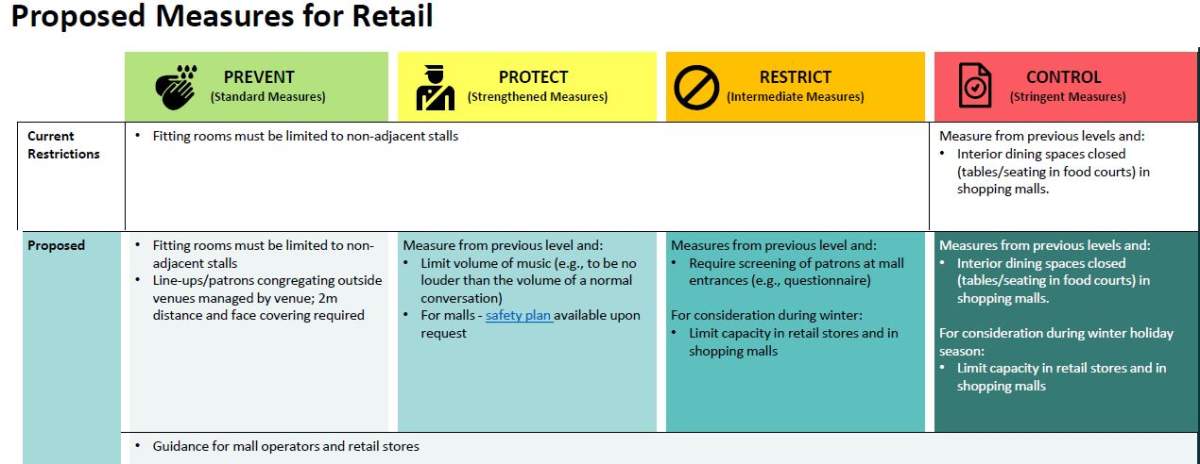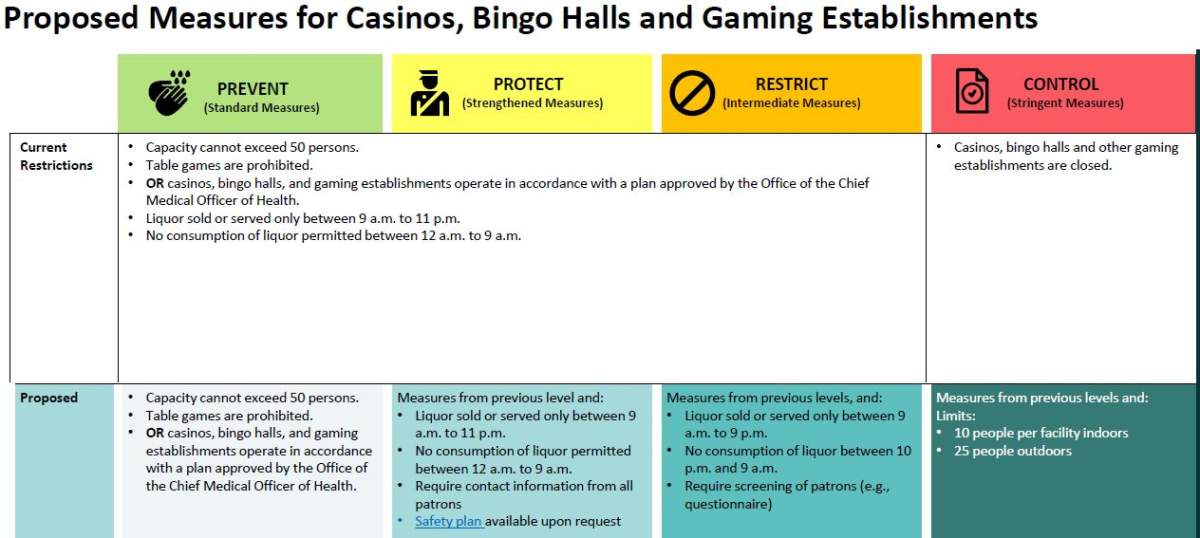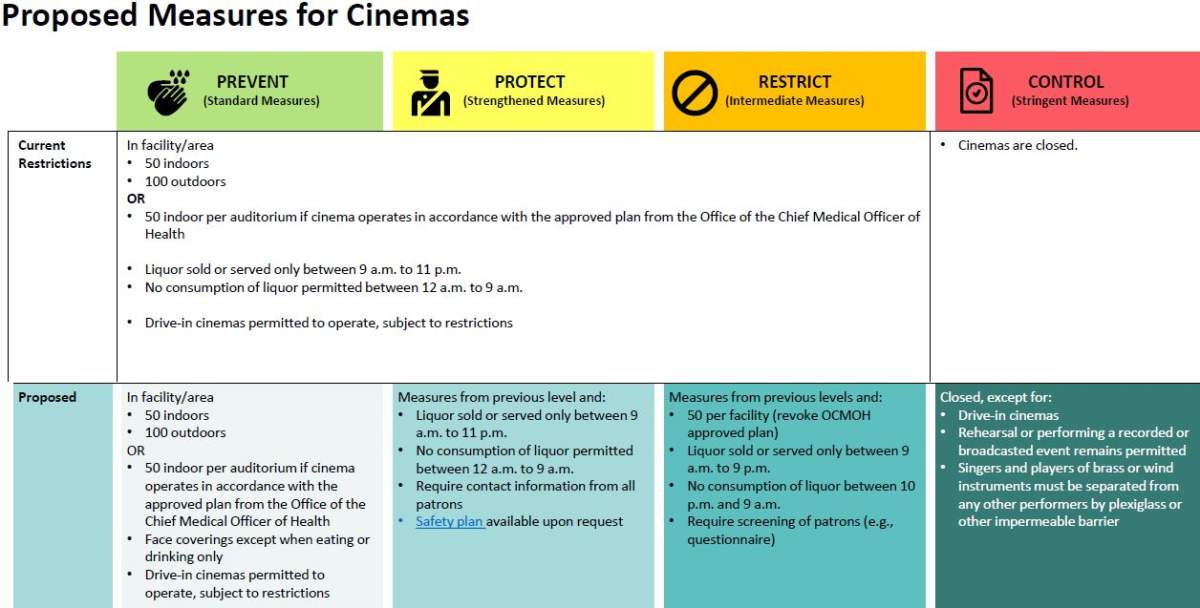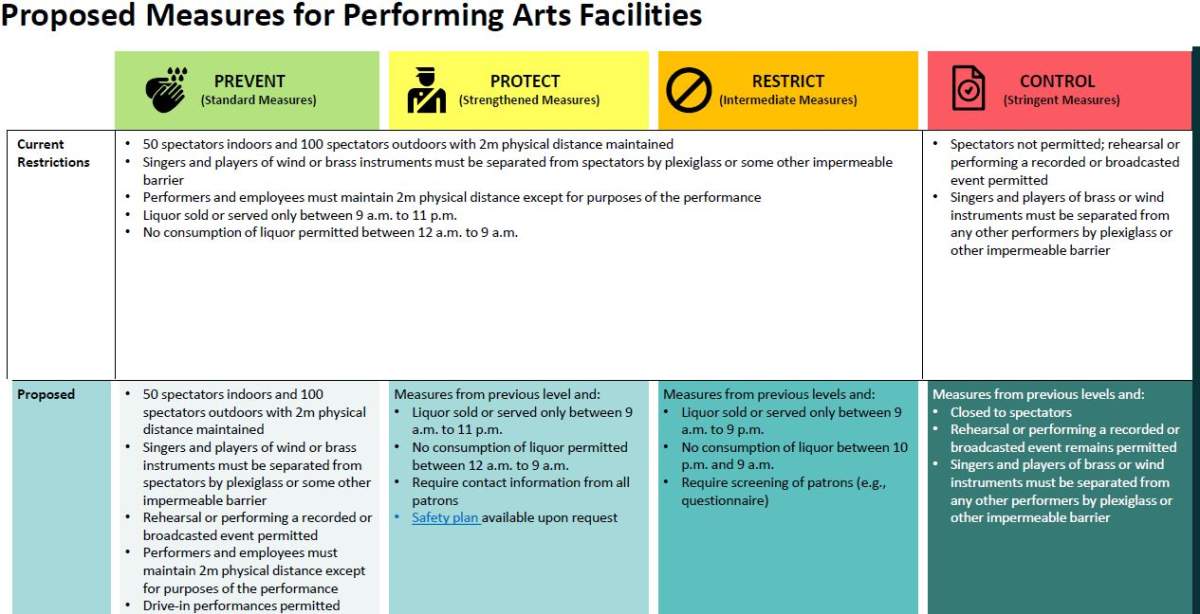The Ontario government unveiled its new plan of proposed measures for the province’s municipalities on Tuesday, in the wake of calls for more fair and targeted shutdowns and/or restrictions amid the coronavirus pandemic.

Premier Doug Ford made the announcement alongside Ontario Minister of Health Christine Elliott and Chief medical Officer of Health (CMOH) Dr. David Williams at his daily press conference at Queen’s Park.
In a document entitled, “COVID-19 Response Framework: Keeping Ontario Safe and Open,” the government outlines its priorities and principles for the province as it deals with the second wave of the coronavirus pandemic, which has seen numbers in the 700s and higher for the past several weeks.
“We’re giving you a clear understanding of where you are as a region,” Ford said. “I know that you want access to more data. I know you want predictability.”
According to the documents, close contact is the highest risk of transmitting the virus, which highlights the need for people to continue to physically distance, stay home when ill, wash hands frequently, and wear a mask.
Toronto, Peel Region and Ottawa have seen the highest case counts during the second wave and were therefore placed in a “modified Stage 2” shutdown for 28 days, which ends Nov. 7. York Region followed shortly after.
The new framework aims to adjust and/or tighten measures as “trends in public health indicators improve.”
The following levels were used: Prevent (standard measures — green), protect (strengthened measures — yellow), restrict (intermediate measures — orange), control (stringent measures — red), and lockdown (maximum measures — grey).
The goal is to have all public health unit regions in the “prevent” level. The system goes into effect 12:01 a.m. Saturday.
Most regions are to be in the Prevent level, with the exception of Brant County, Hamilton, Durham and Halton, which are in Protect level and Eastern Ontario, Ottawa, Peel, Toronto and York which are in the Restrict level.
Ford said those regions in the “modified Stage 2”, except Toronto, will move to the Restrict level at 12:01 a.m. Nov. 7. Ford said Toronto Mayor John Tory asked for one more week to Nov. 14, until the city follows suit, to which the premier agreed.
“This new framework provides a path forward that will help us get to a situation where establishments can open their doors safely,” Mayor John Tory said in a statement.
“It’s clear COVID-19 will be with us for a while, which is why we are putting in place a framework that will protect the health and safety of individuals and families, while avoiding broader closures across the province,” Ford said.
Regions move from different levels depending on positivity rates and case numbers, among other things. Under the new system, a region that moves up into a category with tighter restrictions will stay there for 28 days.
“Indicators will generally be assessed based on the previous two weeks of information,” the document said. “However, movement to apply measures will be considered sooner than two weeks if there is a rapidly worsening trend.”
The new proposed levels have their own measures in place for the different categories of restaurants and bars, sports and recreational fitness, meeting and event spaces, retail, personal care services, casinos, bingo halls and gaming establishments, cinemas and performing arts facilities.

Get weekly health news
The new proposed measures are based off data from the week of Oct. 26. Once the CMOH and cabinet have updated and reviewed data, final approval of the measures will be made.
Restaurants and bars
Prevention:
•Require patrons to be seated; 2m minimum between tables
•Dancing, singing and performing music is permitted, with restrictions
•Karaoke permitted, with restrictions (including no private rooms)
•Require patron contact info (one per group)
•No buffet style service
•Night clubs only permitted to operate as restaurant or bar
•Line-ups/patrons congregating outside venues managed by venue; 2m distance and face covering required
•Face coverings except when eating or drinking only
•Eye protection where patrons without face coverings are within two metres of workers
Control: Measures from all previous three levels, however, there is only a 10-person limit indoors. Takeout, outdoor dining, drive through and delivery are allowed. Dancing, singing and live performances with brass or wind instruments are not allowed.
Sports and recreational fitness
Prevention:
•50 people indoors (classes)
•100 people outdoors (classes)
•50 people indoors (area with weights or exercise equipment)
•Spectators allowed (50 indoors and 100 outdoors)
•Limit of 50 people per room basis if operating in compliance with a plan approved by the Office of the Chief Medical Officer of Health (Guidance for Facilities for Sport and Recreational Activities)
•Team or individual sports must be modified to avoid physical contact; 50 people per league
•Exemption for high performance athletes and parasports
•Limit volume of music (e.g., conversation level)/require use of microphone for instructor where needed to avoid shouting
Control: Measures from three previous levels, however gyms and fitness studios can only have 10 people indoors for classes and areas with weights or equipment. All sports and recreational programs inside can only have 10 people indoors and 25 outdoors. Team sports are not to be practiced or played except for training where no scrimmages are allowed).
Meeting and event spaces
Prevention: 50 people indoors, 100 people outdoors (exceptions for court/government services, weddings and funerals), and booking multiple rooms for an event is not permitted.
Control: Measures from the previous three levels, however, only 10 people allowed indoor and 25 outdoors.
Retail
Prevention: fittings room can operate, however, must be limited to non-adjacent stalls, lineups must me managed by the store, physical distancing and masks required.
Control: All measures from previous three levels plus inside dining areas (i.e. food courts) are closed plus capacity limits during winter holiday season for stores and shopping malls.
Personal care services
Prevention: Oxygen bars, steam rooms, saunas and whirlpools are closed.
Control: All measures from previous levels plus services requiring removal or face coverings are not allowed.
Casinos, bingo halls and gaming establishments
Prevention: No more than 50 people allowed inside establishments, table games allowed or all establishments “operate in accordance with a plan approved by the Office of the Chief Medical Officer of Health.”
Control: All measures from previous three levels plus only 10 people allowed indoors and 25 outdoors.
Cinemas
Prevention: 50 people indoors, 100 outdoors or 50 people allowed per theatre room in accordance with public health, face coverings except when eating or drinking, drive-in cinemas open.
Control: All theatres closed except for drive-ins, however, rehearsals or recorded and broadcast events still allowed.
Performing arts facilities
Prevention: 50 people indoors, 100 outdoors with physical distancing in place, singers/players of wind or brass instruments separated from spectators, rehearsals or performing a recorded/broadcasted event and drive-in performances allowed, performers and employees must maintain physical distancing.
Control: No spectators allowed, however, rehearsals or recorded and broadcast events still allowed.
The official Opposition expressed a lack of confidence in the plan Tuesday, saying many communities and small businesses simply can’t afford to “slide in and out” of closures as they move between tiers.
“We’re quite concerned about the flexibility in this program that is being unveiled by the government,” NDP legislator Taras Natyshak said, adding more support is needed to help businesses navigate the uncertainty.
Some in the medical community expressed similar concerns.
Infectious diseases physician Dr. Isaac Bogoch pointed to the measures for communities in the province’s orange category — which allows for up to a ten per cent positivity rate in a community — as potentially too loose.
“Some of the metrics are too forgiving,” he said on Twitter.
“These would allow for significant community spread without imposing measures to curb transmission.”
Dr. Michael Warner, the medical director of critical care at Michael Garron Hospital, said the new rules enable economic reopening at the expense of health and safety.
“The framework proposed by (Premier Ford) enshrines exponential spread as acceptable,” he wrote in a post online.
The province also announced Tuesday that it will make up to $300 million available to businesses forced to shut down because of the restrictions imposed in hot spot regions.
Those businesses can apply to the province starting Nov. 16 to help to pay their property taxes and energy costs.
As of Tuesday, Ontario reported a single-day record high of 1,050 coronavirus cases, bringing the provincial total to 78,705.
According to Tuesday’s provincial report, 408 new cases were recorded in Toronto, 212 in Peel Region, 86 in Halton Region, 76 in York Region, 57 in Durham Region, 34 each in Ottawa and Hamilton, and 31 in Niagara.
—With files from Gabby Rodrigues and The Canadian Press


















Comments